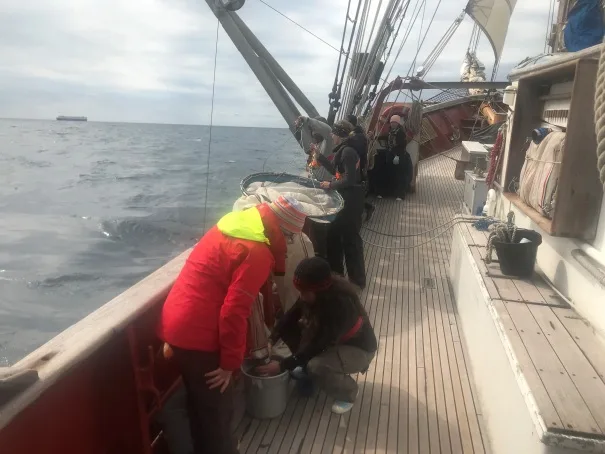Programs Blog
Sample New York City’s Hidden Canyon

Andrew Meashaw, A-Watch, SUNY Environmental Science and ForestryCurrent Position
39° 48.9’N x 072° 41.9’W
Course and Speed
340°, 6.1 knotts
Sail Plan
Tops’l, Jib, Forestas’l, Mainsatys’l, Shallow Reefed Mains’l
Weather
10.5°C, Cloudy, Wind ExN force 4
Souls on BoardAlthough millions of people live less than a hundred miles away from it, very few people know about one of the largest canyons in the United States, Hudson Canyon. This amazing underwater landmark is located south east of New York City and is the largest marine canyon on the United Sates Atlantic Coast. It supports a large array of organisms and has been nominated to be a National Marine Sanctuary.
We were asked by Wildlife Conservation Society’s (WCS) New York Seascape’s program to do some sampling here since we would pass right over it on our way to NYC. This was not going to be like the normal science stations we have been doing as we transected the Sargasso Sea; this time, students planned the sampling. Together we devised what areas we should get samples from, what data should be collected at the stations, and how to get the Cramer where we needed to be.
Today we got to put our plan into action, performing transects across the canyon collecting data and executing multiple science stations. It was very rewarding and exciting to see all of our planning and work pay off…. and we even got see sharks!!! There was also a little sadness in the air as these were the last few science stations of the cruise. But we do have a few more things to look forward to before departing from the Cramer! Following our arrival, the students will have an amazing opportunity this Friday to share our love for this science with WCS and local high school students at the New York City Aquarium. During this engagement session, we will get to present our findings from our canyon samples. For now though, we are all trying to enjoy our remaining time at sea before arriving in Brooklyn around 0900 tomorrow.
– Andrew Meashaw, A-Watch, SUNY Environmental Science and Forestry
Recent Posts from the Ships
- Ocean Classroom 2024-A collaborative high school program with Proctor Academy
- Collaborations and Long-term Commitments: SEA’s Caribbean Reef Program Sets a Course for Coastal Programs that Compliment Shipboard Experiences.
- Sea Education Association students prepare for life underway using state of the art nautical simulation from Wartsila Corporation.
- SEA Writer 2022, Magazines From the Summer SEA Quest Students
- Technology@SEA: Upgrades Allow Insight into Ocean Depths
Programs
- Gap Year
- Ocean Exploration
- High School
- Science at SEA
- SEA Expedition
- SEAScape
- Pre-College
- Proctor Ocean Classroom
- Protecting the Phoenix Islands
- SPICE
- Stanford@SEA
- Undergraduate
- Climate and Society
- Climate Change and Coastal Resilience
- Coral Reef Conservation
- Marine Biodiversity and Conservation
- MBL
- Ocean Exploration: Plastics
- Ocean Policy: Marine Protected Areas
- Oceans and Climate
- Pacific Reef Expedition
- The Global Ocean: Hawai'i
- The Global Ocean: New Zealand